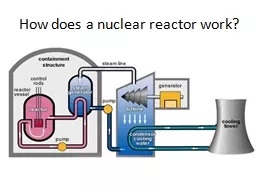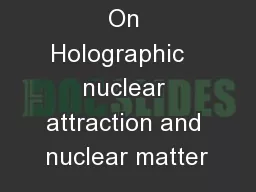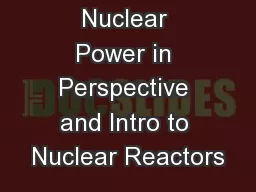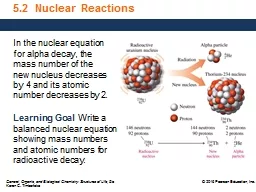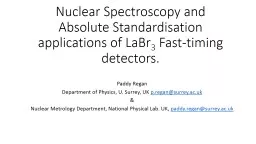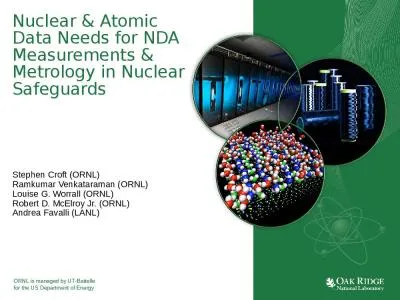PPT-Requirements from French Nuclear
Author : cheryl-pisano | Published Date : 2019-06-22
Safety Authority on Beryllium activities Joelle ElbezUzan Environmental Protection amp Nuclear Safety Division ITER Organization Licensing roadmap for staged
Presentation Embed Code
Download Presentation
Download Presentation The PPT/PDF document "Requirements from French Nuclear" is the property of its rightful owner. Permission is granted to download and print the materials on this website for personal, non-commercial use only, and to display it on your personal computer provided you do not modify the materials and that you retain all copyright notices contained in the materials. By downloading content from our website, you accept the terms of this agreement.
Requirements from French Nuclear: Transcript
Safety Authority on Beryllium activities Joelle ElbezUzan Environmental Protection amp Nuclear Safety Division ITER Organization Licensing roadmap for staged approach Be is very important for the staged approach licensing. Milos. June 2011. . V. . Kaplunovsky. . A. . Dymarsky. , D. . Melnikov. and S. Seki, . Introduction. In recent years . holography. or . gauge/gravity duality. has provided a new tool to handle strong coupling problems.. Sunshine Act And Decree. “Current Issues In Compliance”, Webinar . #5 . June 5/6. th. , 2013 . Webinar Logistics. Questions . We welcome questions and ask that you submit them through the “chat” feature of the pop-up window in the webinar. We . How it works?. Just as conventional power-stations generate electricity by harnessing the . thermal energy . released from . . burning fossil fuels, . nuclear reactors convert the thermal energy released from . Nuclear power plant. 2. NUCLEAR FUEL. Nuclear . fuel is any material that can be consumed to derive nuclear energy. The most common type of nuclear fuel is fissile elements that can be made to undergo nuclear fission chain reactions in a nuclear reactor . GGI May 2011. . V. . Kaplunovsky. . A. . Dymarsky. , D. . Melnikov. and S. Seki, . Introduction. In recent years . holography. or . gauge/gravity duality. has provided a new tool to handle strong coupling problems.. Nuclear chemistry is the study of the structure of and the they undergo.. atomi. c nuclei. changes. Chemical vs. Nuclear Reactions. Top Nuclear Generating Countries. Nuclear Reactors - 7/13/17 - ©The NEED Project . Nuclear Energy Production. Although the national percentage of nuclear generated electricity is about 19%, it varies from state to state.. On a piece of . paper respond . to the following:. Briefly list and describe . THREE. causes . of the French Revolution. (Its okay if you are only guessing). Which cause of the three do you think is the . Learn French Language with Edubull French Language Course Online. Looking for French Lessons in French Language Classes, introduction to the French Language Basics with the French Language Learning App. Causes of the French Revolution What brought about the French Revolution? Enlightenment thinkers ~ many lived in France under absolute monarchy ~ spoke of change granting more rights to the people….sounded good! The Old Regime. 1. st. Estate – Clergy - 1% of population. 2. nd. Estate – Nobility – 1% of population. 3. rd. Estate – Remainder of population. The Clergy. Very wealthy and powerful. Owned 10% of the land in France. Learning Goal . Write a balanced nuclear equation showing mass numbers and atomic numbers for radioactive decay.. Balancing Nuclear Equations. In a process called . radioactive decay. , the nucleus breaks down by emitting radiation. . Standards. Paddy Regan. Department of Physics, U. Surrey, UK . p.regan@surrey.ac.uk. &. Nuclear Metrology Department, National Physical Lab. UK, . paddy.regan@surrey.ac.uk. . Outline:. Introduction to radioisotope physics. Stephen Croft (ORNL). Ramkumar Venkataraman (ORNL). Louise G. Worrall (ORNL). Robert D. McElroy Jr. (ORNL). Andrea Favalli (LANL). Acknowledgement. This work was sponsored in part by the U.S. Department of Energy (DOE), National Nuclear Security Administration (NNSA), Office of Defense Nuclear Nonproliferation Research and Development (NA-22) and in part by ORNL and LANL..
Download Document
Here is the link to download the presentation.
"Requirements from French Nuclear"The content belongs to its owner. You may download and print it for personal use, without modification, and keep all copyright notices. By downloading, you agree to these terms.
Related Documents



